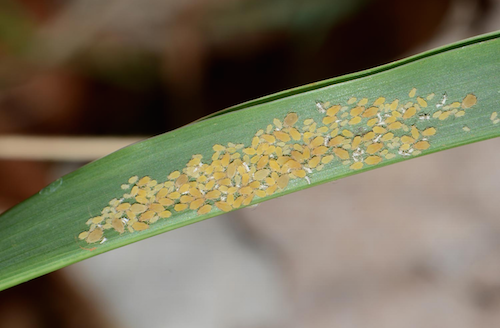The sugarcane aphid has now been reported in Cowley County. Grain sorghum producers in Kansas should begin scouting their fields on a routine basis.
What can we expect this season? It’s impossible to know for sure at this time. Infestations in Kansas in 2017 were sporadic, and most issues were late season (Figure 2). But in 2016, sugarcane aphids were a significant problem on grain sorghum in Kansas, Texas, Oklahoma, and most southern states, and fields were justifiably sprayed to protect yields.
Early detection is key to the management of this pest, but treatments should be based on established thresholds. One heavily infested plant does not equal a yield loss. Applying insecticides too soon can result in repeated applications, which occurred during the 2015 season. See scouting and treatment recommendations below.
Scouting time
Plants are vulnerable to infestation by SCA at any growth stage, but Kansas sorghum is most at risk from boot stage onward. The ability of sugarcane aphid to overwinter on Johnsongrass and re-sprouting sorghum stubble represents challenges to the management of this pest in more southerly regions.
In 2017, the SCA overwintered as asexual females on Johnsongrass rhizomes in south central Texas and northern Mexico. Infestations begin when swarms of winged aphids settle in a field and begin to establish colonies, which usually occurs after a large storm front pushes aphids from south to north. Once winged adults deposit nymphs, these immature aphids can mature in less than a week, lack wings, and have a much higher reproductive rate than their winged mothers. Established colonies of wingless aphids quickly become large and crowded, which causes winged forms to develop, until the final generation is exclusively winged once again. Thus, the trend will be for Kansas to receive SCA only after infestations to the south mature and produce winged migrants. Growers are advised to plant sorghum as early as agronomically feasible to maximize plant growth and maturity before aphids arrive. In 2017, large flights of winged sugarcane aphid arrived in Kansas somewhat later than in 2016 and a smaller area of the state was affected, despite cold wet spring weather in the south that delayed the aphids initially. It remains to be seen how the 2018 season will develop, but given the slow march across Texas and Oklahoma, we expect to see something similar to last year.
Sampling method
- Once a week, walk 25 feet into the field and examine plants along 50 feet of row:
- If honeydew is present, look for SCA on the underside of a leaf above the honeydew.
- Inspect the underside of leaves from the upper and lower canopy from 15 to 20 plants per location.
- Sample each side of the field as well as sites near Johnsongrass and tall mutant plants.
- Check at least 4 locations per field for a total 4 locations per field for a total of 60 to 80 plants.
If no SCA are present, or only a few wingless/winged aphids are on upper leaves, repeat this sampling method once a week thereafter.
If SCA are found on lower or mid-canopy leaves, begin twice-a-week scouting. Use the same sampling method, but be sure to include percent plants with honeydew. Estimate the percent of infested plants with large amounts of SCA honeydew (shiny, sticky substance on leaf surface) to help time foliar insecticides for SCA control on sorghum (Table 1).




